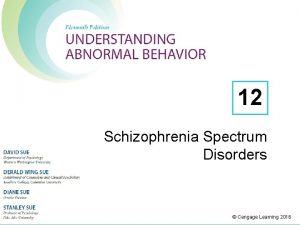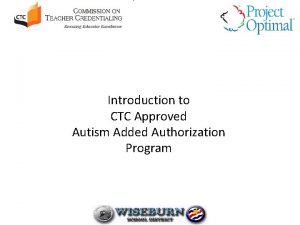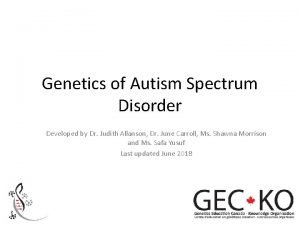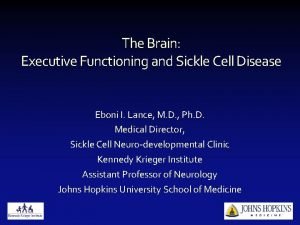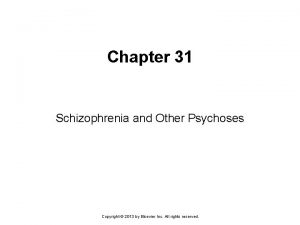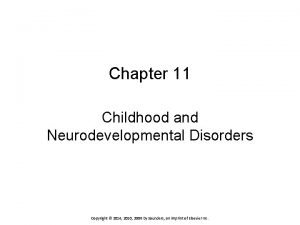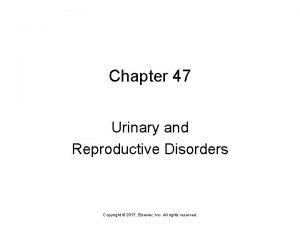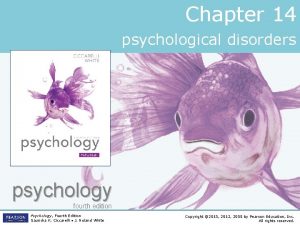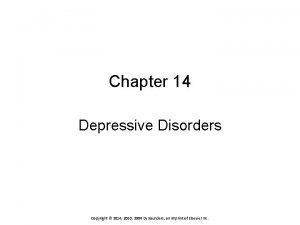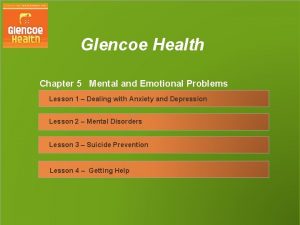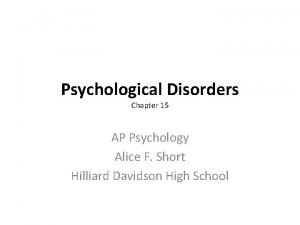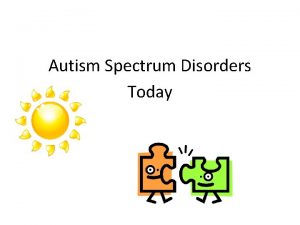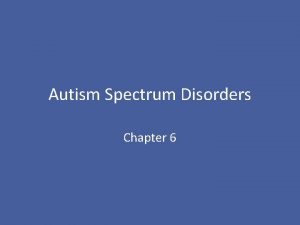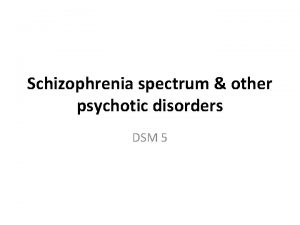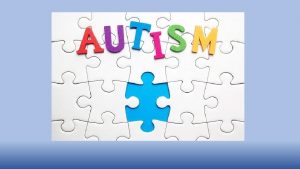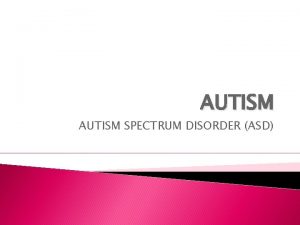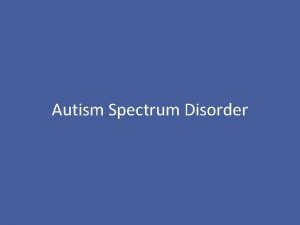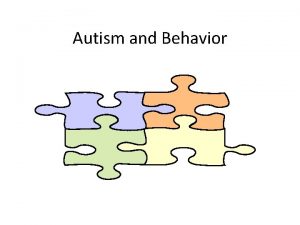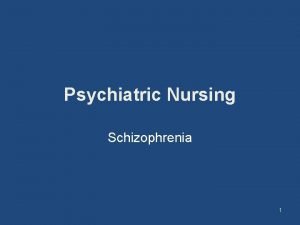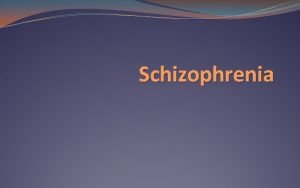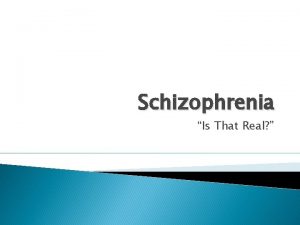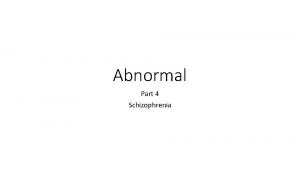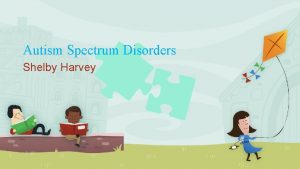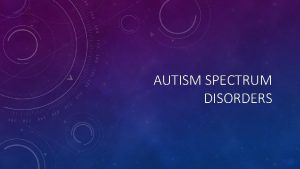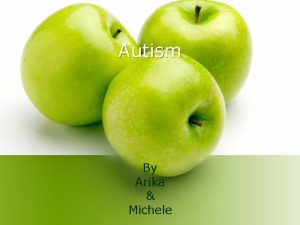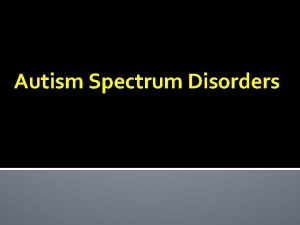Chapter 10 Autism Spectrum Disorders and ChildhoodOnset Schizophrenia




![[INSERT VIDEO: “autism_diagnosis. mov”] Mash/Wolfe Abnormal Child Psychology, 4 th edition © 2009 Cengage [INSERT VIDEO: “autism_diagnosis. mov”] Mash/Wolfe Abnormal Child Psychology, 4 th edition © 2009 Cengage](https://slidetodoc.com/presentation_image/f1b0b46dcfcf3cbf444e217c7f6283b1/image-5.jpg)

































- Slides: 38

Chapter 10 Autism Spectrum Disorders and Childhood-Onset Schizophrenia Mash/Wolfe Abnormal Child Psychology, 4 th edition © 2009 Cengage Learning

Autism Spectrum Disorders Autism spectrum disorders (autism): severe developmental disorders characterized by abnormalities in social functioning, language and communication, and unusual behaviors and interests Description and History § Pervasive developmental disorders (PDDs): characterized by significant impairments in social and communication skills, and by stereotyped patterns of interests and behaviors Autustic Disorder Asperger’s Disorder Pervasive Developmental Disorder, Not Otherwise Specified (PDD-NOS) Rett’s Disorder Childhood Disintegrative Disorder Mash/Wolfe Abnormal Child Psychology, 4 th edition © 2009 Cengage Learning

Autism Spectrum Disorders (cont. ) Description and History (cont. ) § Kanner (1943) coined the term “early infantile autism” to describe young children with autistic symptoms preservation of sameness: anxious and obsessive insistence on maintaining sameness in daily routines and activities, which no one but the child may disrupt § Kanner: autism is an inborn deficit in children whose “refrigerator parents” are intelligent, obsessive, cold, mechanical, and detached in their relationships § Current view: biologically based lifelong developmental disability that is present in the first few years of life § Children with autism behave in bizarre ways, engaging in stereotyped or repetitive motor activities for hours, or focusing on miniscule details of their world Mash/Wolfe Abnormal Child Psychology, 4 th edition © 2009 Cengage Learning

DSM-IV-TR Criteria for Autism Impairments in social interaction Impairments in communication Restricted repetitive and stereotyped patterns of behavior, interests, and activities Delays or abnormal functioning in social interaction, social communication, or symbolic or imaginative play prior to age 3 Mash/Wolfe Abnormal Child Psychology, 4 th edition © 2009 Cengage Learning
![INSERT VIDEO autismdiagnosis mov MashWolfe Abnormal Child Psychology 4 th edition 2009 Cengage [INSERT VIDEO: “autism_diagnosis. mov”] Mash/Wolfe Abnormal Child Psychology, 4 th edition © 2009 Cengage](https://slidetodoc.com/presentation_image/f1b0b46dcfcf3cbf444e217c7f6283b1/image-5.jpg)
[INSERT VIDEO: “autism_diagnosis. mov”] Mash/Wolfe Abnormal Child Psychology, 4 th edition © 2009 Cengage Learning

Autism as a Spectrum Disorder Autism Across the Spectrum § Symptoms, abilities, and characteristics of autism are expressed in many different combinations and degrees of severity § Three factors contribute to the spectrum nature of autism: children with autism may differ in level of intellectual ability, from profound retardation to above-average intelligence children with autism vary in the severity of their language problems the behavior of children with autism changes with age Mash/Wolfe Abnormal Child Psychology, 4 th edition © 2009 Cengage Learning

Core Deficits of Autism Social Impairments: § deficits in social and emotional reciprocity § unusual nonverbal behaviors (e. g. , atypical facial expressions) § lack of interest and/or difficulty relating to others § failure to share enjoyment/interests with others § social imitation, sharing focus of attention, make-believe play § limited social expressiveness and sensitivity to social cues § deficits in recognizing faces/facial expressions § joint attention: ability to coordinate attention to a social partner and object/event of mutual interest; impairment impedes later language development § although children with autism are attached to their parents, the way they express attachment is unusual and difficult to read Mash/Wolfe Abnormal Child Psychology, 4 th edition © 2009 Cengage Learning

Core Deficits of Autism (cont. ) Communication Impairments: § One of the first signs of language impairment is inconsistent use of early preverbal communications use protoimperative gestures (gestures or vocalizations to express needs) not protodeclarative gestures (those that direct visual attention of others to objects of shared interest) miss other declarative gestures, such as showing gesture about 50% do not develop any useful language Mash/Wolfe Abnormal Child Psychology, 4 th edition © 2009 Cengage Learning

Core Deficits of Autism (cont. ) Communication Impairments (cont. ) Those who begin to speak may regress between ages 12 -30 months; those who do develop language do so before age 5 May use instrumental rather than expressive gestures to convey feelings Qualitative language impairments: pronoun reversals, echolalia, impairments in pragmatics Mash/Wolfe Abnormal Child Psychology, 4 th edition © 2009 Cengage Learning

Core Deficits of Autism (cont. ) Repetitive Behaviors and Interests: § Repetitive and stereotyped behaviors and narrow patterns of interest § Stereotyped body movements § Self-stimulatory behavior (e. g. , hand flapping) Different theories to explain self-stimulatory behaviors: § a craving for stimulation to excite their nervous system § a way of blocking out/controlling unwanted stimulation from environment that is too stimulating § it is reinforcing Mash/Wolfe Abnormal Child Psychology, 4 th edition © 2009 Cengage Learning

Associated Characteristics of Autism Intellectual Deficits and Strengths § About 70% of autistic children have co-occurring intellectual impairment about 40% have severe to profound impairments (IQ<50) 30% have mild to moderate impairments (IQ 50 -70) 30% have average intelligence or above although the performance of children with autism is uneven across WISC subtests, a common pattern is low verbal/high nonverbal scores; WISC scores are lower than on other tests of intellectual functioning § about 25% have splinter skills/islets of ability; and 5% (autistic savants) display isolated, remarkable talents Mash/Wolfe Abnormal Child Psychology, 4 th edition © 2009 Cengage Learning

Associated Characteristics of Autism (cont. ) Sensory and Perceptual Impairments § Sensory abnormalities are common in children with autism oversensitivities or undersensitivities to certain stimuli overselective/impaired shifting of attention to sensory input impairments in mixing across sensory modalities (e. g. , inability to see the movement and hear the sound of someone clapping simultaneously) sensory dominance: tendency to focus on certain types of sensory input over others stimulus overselectivity: tendency to focus on one feature of an object or event in the environment while ignoring other equally important features Mash/Wolfe Abnormal Child Psychology, 4 th edition © 2009 Cengage Learning

Associated Characteristics of Autism (cont. ) Cognitive and Motivational Deficits § Deficits in Processing Social-Emotional Information do not understand pretense or engage in pretend play difficulty understanding social situations deficit in mentalization or theory of mind (To. M): difficulty understanding others’ and their own mental states; do not understand false beliefs § General Deficits executive functioning (higher-order planning and regulatory behaviors) weak drive for central coherence (strong human tendency to interpret stimuli in a relatively global way to account for broader context) Mash/Wolfe Abnormal Child Psychology, 4 th edition © 2009 Cengage Learning

Associated Characteristics of Autism (cont. ) Physical Characteristics § Coexisting medical condition for about 10% § Sleep disturbances and gastrointestinal symptoms are common § Normal or attractive physical appearance, although they may have subtle yet distinctive minor physical anomalies about 20% have a significantly larger-than-normal head size, which is more common in those who are higher functioning § Accompanying disorders and symptoms: most common are MR and epilepsy (25% or more may develop epilepsy) also: ADHD, learning disabilities, anxieties and fears, and mood problems self-injurious behaviors, including head banging, hand or arm biting, excessive scratching and rubbing Mash/Wolfe Abnormal Child Psychology, 4 th edition © 2009 Cengage Learning

Prevalence and Course of Autism Worldwide, about 1 child per 150 may suffer from some form of autism; about 1 million individuals in the United States § Autistic disorder: 22 of 10, 000 § PPD-NOS: 33 of 10, 000 § Asperger’s disorder: 10 of 10, 000 Occurs in all social classes and cultures 3 -4 times more common in boys; when girls are affected they tend to have more severe intellectual impairments Extreme male brain theory of autism (Simon Baron-Cohen): males are presumed to show relatively more systemizing and females show more empathizing Mash/Wolfe Abnormal Child Psychology, 4 th edition © 2009 Cengage Learning

Prevalence and Course of Autism (cont. ) Age of Onset § Most often identified by parents in the months preceding child’s second birthday, with diagnosis made in preschool period or later § Earliest point in development for reliable detection: 12 -18 months AAP recommends that all children be screened at 1824 months Mash/Wolfe Abnormal Child Psychology, 4 th edition © 2009 Cengage Learning

Prevalence and Course of Autism (cont. ) Course and Outcome § Often gradual improvements with age, but likely to continue to experience many problems, with some symptoms worsening in adolescence § Complex obsessive-compulsive rituals may develop in late adolescence and adulthood § Usually a chronic and lifelong condition with continuing handicaps that do not allow for high levels of independence § Continuing problems in communication, stereotyped behaviors and interests, poor reading and spelling abilities IQ and language development are the strongest predictors of adult outcomes Mash/Wolfe Abnormal Child Psychology, 4 th edition © 2009 Cengage Learning

Causes of Autism It is generally accepted that autism is a biologically based neurodevelopmental disorder with multiple causes Problems in Early Development § Sometimes problems during pregnancy, at birth, or immediately following birth § Controversial proposal links autism to vaccinations Genetic Influences § Chromosomal and Gene Disorders: fragile-X anomaly in 2 -3% of children with autism 5% elevated risk for chromosomal anomalies about 25% of children with tuberous sclerosis have autism Mash/Wolfe Abnormal Child Psychology, 4 th edition © 2009 Cengage Learning

Causes of Autism (cont. ) Genetic Influences (cont. ) § Family and Twin Studies 3 -7% of siblings and extended family members of individuals with autism have the disorder Concordance rates § 60 -90% in identical twins § near 0% for fraternal twins § heritability of an underlying liability to autism is 80% § broader autism phenotype: non-autistic relatives of individuals with autism display higher than normal rates of social, language, and cognitive deficits that are similar in quality to those found in autism, but are less severe Mash/Wolfe Abnormal Child Psychology, 4 th edition © 2009 Cengage Learning

Causes of Autism (cont. ) Genetic Influences (cont. ) § Molecular Genetics: Points to particular areas on many different chromosomes as possible locations for susceptibility genes for autism causally implicated but not a direct cause most cases result from multiple interacting genetic factors expression of autism genes may be influenced by environmental factors occurring primarily during fetal brain development Mash/Wolfe Abnormal Child Psychology, 4 th edition © 2009 Cengage Learning

Causes of Autism (cont. ) Genetic Influences (cont. ) § Brain Abnormalities Early disturbance in neural development prior to 30 weeks before birth Observed deficits suggest involvement of multiple brain regions at both cortical and subcortical levels Biological findings: frontal lobe cortex abnormalities; structural abnormalities in cerebellum and medial temporal lobe and related limbic system structures § decreased blood flow in the frontal and temporal lobes; elevated blood serotonin in 1/3 of cases Autism as a Disorder of Risk and Adaptation: The relationship between early risk for autism and later outcomes is mediated by alterations in how the child interacts with/adapts to his or her environment Mash/Wolfe Abnormal Child Psychology, 4 th edition © 2009 Cengage Learning

Treatment of Autism There is no known cure for autism Treatment goals: minimize core problems, maximize independence and quality of life, and help the child and family cope more effectively with the disorder Most benefit is likely to come from programs of § early intervention that involve parents and use special educational methods § community-based education, community living options § developmentally oriented Different Children, Different Treatments § Treatment strategies, goals, and expectations vary for different children with autism Mash/Wolfe Abnormal Child Psychology, 4 th edition © 2009 Cengage Learning

Treatment of Autism (cont. ) Overview § Treatments focus on social, communication, cognitive, and behavioral deficits associated with autism § Strategies include: engaging children in treatment decreasing disruptive behaviors teaching appropriate social behavior (e. g. , joint attention, imitation, reciprocal interaction) increasing functional, spontaneous communication promoting cognitive skills (e. g. , symbolic play and perspective taking) teaching adaptive skills to increase responsibility and independence Mash/Wolfe Abnormal Child Psychology, 4 th edition © 2009 Cengage Learning

Treatment of Autism (cont. ) Overview (cont. ) § Treatment components: Initial stages: build rapport, teaching learningreadiness skills § discrete trial training: step-by-step approach to presenting stimulus/requiring specific response § incidental training: strengthen behavior by capitalizing on naturally occurring opportunities Reduce disruptive behavior Teach appropriate social behavior Teach appropriate communication skills: operant speech training Mash/Wolfe Abnormal Child Psychology, 4 th edition © 2009 Cengage Learning

Treaetment of Autism (cont. ) Early Intervention § The most effective interventions include the following features: Early: begin as soon as diagnosis is seriously considered Intensive Low student-teacher ratio High structure Family inclusion Peer interactions Generalization Ongoing assessment § The UCLA Young Autism Project: highly structured skillsoriented strategies tailored to the individual child; provide education and supportive counseling for the family Mash/Wolfe Abnormal Child Psychology, 4 th edition © 2009 Cengage Learning

Treatment of Autism (cont. ) Medications § Many children with autism receive psychotropic medications: antidepressants, stimulants, tranquilizers/ antipsychotics benefits are limited, variable from child to child, and do not alter the core deficits of these children risks, benefits, and costs must be carefully evaluated Mash/Wolfe Abnormal Child Psychology, 4 th edition © 2009 Cengage Learning

Other Pervasive Developmental Disorders (PDDs) Asperger’s Disorder (AD): major difficulties in social interaction and unusual patterns of interests and behaviors in children with relatively intact cognitive and communication skills § compared to autism, children with AD have similar social impairments and restricted, stereotyped interests but higher verbal mental age, less language delay, and greater interest in social contact § lack empathy; inappropriate, one-sided social interaction; little ability to form friendships; socially isolated; poor nonverbal communication § codisorders: anxiety disorders (especially social phobias and obsessive-compulsive symptoms) and sleep difficulties § higher intellectual functioning suggests better long-term outcome than for autism § brain abnormalities in the cerebellum and limbic system similar to those for autism, but less severe Mash/Wolfe Abnormal Child Psychology, 4 th edition © 2009 Cengage Learning

Other PDDs (cont. ) Rett’s Disorder: severe and disabling neurological developmental disorder that predominantly affects females; characterized by: deceleration of head growth loss of previously acquired purposeful hand skills and development of stereotyped hand movements early loss of social engagement (often develops later) appearance of poorly coordinated gait or trunk movements severely impaired language development and psychomotor retardation § Prevalence about 1 per 10, 000 to 1 in 22, 000 females § Specific X-linked gene mutations found in up to 95% of those affected (the mutations are usually lethal to the male fetus) § Poor long-term prognosis: 25% may never walk and 50% of those who do walk will later lose the ability Mash/Wolfe Abnormal Child Psychology, 4 th edition © 2009 Cengage Learning

Other PDDs (cont. ) Childhood Disintegrative Disorder: characterized by a significant loss of previously acquired expressive or receptive language, social skills, and adaptive behavior prior to age 10 § regression follows a period of apparently normal development § only occurs in about. 2 per 10, 000 children, mostly boys § symptoms, degree of impairment, and outcomes similar to those of children with autism (except age of onset and the period of normal development) Pervasive Developmental Disorder-Not Otherwise Specified (PDD-NOS/atypical autism): Children who display the social, communication, and behavioral impairments associated with PDD but do not meet criteria for other PDDs, schizophrenia, or other disorders Mash/Wolfe Abnormal Child Psychology, 4 th edition © 2009 Cengage Learning

Childhood Onset Schizophrenia (COS) Schizophrenia: a disorder of the brain that is expressed in abnormal mental functions and disturbed behavior § Characterized by severe psychotic symptoms: bizarre delusions, hallucinations, thought disturbances, grossly disorganized behavior or catatonic behavior, extremely inappropriate or flat affect, and significant deterioration or impairment in functioning Historically, the term “childhood schizophrenia” was applied to children who today would be diagnosed with autism and other PDDs Mash/Wolfe Abnormal Child Psychology, 4 th edition © 2009 Cengage Learning

Childhood-Onset Schizophrenia (cont. ) Compared to autism, COS has later age of onset, less intellectual impairment, less severe social and language deficits, hallucinations and delusions, periods of remission and relapse A rarer and possibly more severe (not distinct) form of schizophrenia Initial stages: problems concentrating, sleeping, doing schoolwork; may avoid friends; as it progresses: incoherent speech, hallucinations Key features: § occurs during childhood § gradual, rather than sudden, onset § symptoms likely persist into adolescence/adulthood § negative impact on developing social and academic competence Mash/Wolfe Abnormal Child Psychology, 4 th edition © 2009 Cengage Learning

Childhood-Onset Schizophrenia (cont. ) DSM-IV-TR: Defining Features § Continuous signs of disturbance for at least 6 months and, after onset, significant decrement in one or more areas of functioning or a failure to achieve expected levels of interpersonal, academic, or occupational achievement § Positive Symptoms: delusions and hallucinations (most common for children are auditory: 80% of cases with onset prior to age 11; 40 -60% experience visual hallucinations, delusions, and thought disorder) § Negative Symptoms: slowing of thinking, speech, movement; indifference to social contact Mash/Wolfe Abnormal Child Psychology, 4 th edition © 2009 Cengage Learning

Childhood-Onset Schizophrenia (cont. ) Precursors and Comorbidities § Gradual onset § Almost 95% have history of behavioral, social, and psychiatric disturbances before onset of psychosis § Developmental precursors: speech and language problems, problems in motor development, movement abnormalities, social impairment, unusual thought content, suspicion/paranoia, substance abuse, and genetic risk with recent deterioration in function § Other symptoms/disorders: anxiety and depression, ADHD, conduct problems, movement abnormalities, suicidal tendencies 70% meet criteria for another diagnosis (commonly mood disorder or ODD/CD) Do NOT show elevated risk of autism or other PDD Mash/Wolfe Abnormal Child Psychology, 4 th edition © 2009 Cengage Learning

Childhood-Onset Schizophrenia (cont. ) Prevalence § Extremely rare in children under age 12; dramatic increase in adolescence; modal age of onset: 20 -25 § Estimated prevalence less than 1. 0 per 10, 000 children (100 times more common in adults than in children) § COS twice as common in boys and earlier age of onset (by 2 -4 years); gender differences disappear in adolescence Mash/Wolfe Abnormal Child Psychology, 4 th edition © 2009 Cengage Learning

Childhood-Onset Schizophrenia (cont. ) Causes and Treatment of COS § Causes Current views: based on a vulnerability-stress model that emphasizes the interplay among vulnerability, stress, and protective factors Neurodevelopmental model: a genetic vulnerability and early neurodevelopmental insults result in impaired connections between many brain regions that include the prefrontal cortex and parts of the limbic system Biological factors: strong genetic contribution in COS with heritability estimates around 80% Molecular genetic studies have identified several potential susceptibility genes for COS that have previously been linked with schizophrenia in adults CNS dysfunction and improvements with medication suggest it is a disorder of the brain Mash/Wolfe Abnormal Child Psychology, 4 th edition © 2009 Cengage Learning

Childhood-Onset Schizophrenia (cont. ) Causes and Treatment of COS (cont. ) § Causes (cont. ) Environmental factors: familial disorder; nongenetic factors may play a role through interaction with a genetic susceptibility § High depression scores for parents on communication deviance (a measure of interpersonal signs of attention and thought disturbance) § Poor family environment and certain patterns of communication interact with genetic risk Mash/Wolfe Abnormal Child Psychology, 4 th edition © 2009 Cengage Learning

Childhood-Onset Schizophrenia (cont. ) Treatment § Current treatments emphasize use of antipsychotic medications combined with psychotherapy plus social and educational support programs § Medications (e. g. , risperidone) help control psychotic symptoms by blocking dopamine transmission adverse effects (which can be serious) reduce adherence to treatment and require constant monitoring § Psychosocial treatments: family intervention, social skills training, cognitive behavior therapy, and educational support Mash/Wolfe Abnormal Child Psychology, 4 th edition © 2009 Cengage Learning

Treatment of COS is a chronic disorder with a poor long-term prognosis Pharmacological treatments, particularly antipsychotic medications, may be used to help control psychotic symptoms Psychosocial treatments, such as social skills training, family intervention, and educational supports are also important Mash/Wolfe Abnormal Child Psychology, 4 th edition © 2009 Cengage Learning
 Chapter 12 schizophrenia spectrum disorders
Chapter 12 schizophrenia spectrum disorders Is schizophrenia on a spectrum
Is schizophrenia on a spectrum Puberty and autism spectrum disorders
Puberty and autism spectrum disorders Ctc autism authorization
Ctc autism authorization Sensory processing disorder dsm
Sensory processing disorder dsm Are there different types of autism
Are there different types of autism Autism spectrum disorder
Autism spectrum disorder Autism spectrum disorder adhd
Autism spectrum disorder adhd Atomic size defination
Atomic size defination Absortpion
Absortpion Chapter 31 schizophrenia and other psychoses
Chapter 31 schizophrenia and other psychoses Chapter 8 skin disorders and diseases
Chapter 8 skin disorders and diseases Chapter 6 musculoskeletal system
Chapter 6 musculoskeletal system Chapter 46 digestive and endocrine disorders
Chapter 46 digestive and endocrine disorders Somatic symptom disorder
Somatic symptom disorder Chapter 29 endocrine and metabolic disorders
Chapter 29 endocrine and metabolic disorders Chapter 21 mental health diseases and disorders
Chapter 21 mental health diseases and disorders Chapter 18 eating and feeding disorders
Chapter 18 eating and feeding disorders Chapter 17 reproductive system diseases and disorders
Chapter 17 reproductive system diseases and disorders Chapter 15 nervous system diseases and disorders
Chapter 15 nervous system diseases and disorders Chapter 15 anxiety and obsessive-compulsive disorders
Chapter 15 anxiety and obsessive-compulsive disorders Chapter 11 childhood and neurodevelopmental disorders
Chapter 11 childhood and neurodevelopmental disorders Elsevier
Elsevier In what situation should a nail service not be performed?
In what situation should a nail service not be performed? Milady chapter 10 nail disorders and diseases
Milady chapter 10 nail disorders and diseases Cardiovascular system diseases and disorders chapter 8
Cardiovascular system diseases and disorders chapter 8 Milady chapter 8 skin disorders and diseases
Milady chapter 8 skin disorders and diseases Chapter 47 urinary and reproductive disorders
Chapter 47 urinary and reproductive disorders An extreme harmful eating behavior
An extreme harmful eating behavior 10 diseases of lymphatic system
10 diseases of lymphatic system Medical model psychology
Medical model psychology Chorionic villus
Chorionic villus Chapter 18 psychological disorders
Chapter 18 psychological disorders Chapter 14 psychological disorders
Chapter 14 psychological disorders Chapter 14 depressive disorders
Chapter 14 depressive disorders Impulse control problems
Impulse control problems Chapter 5 lesson 4 mental and emotional problems
Chapter 5 lesson 4 mental and emotional problems Chapter 14 psychological disorders
Chapter 14 psychological disorders Ap psychology chapter 15 psychological disorders
Ap psychology chapter 15 psychological disorders

